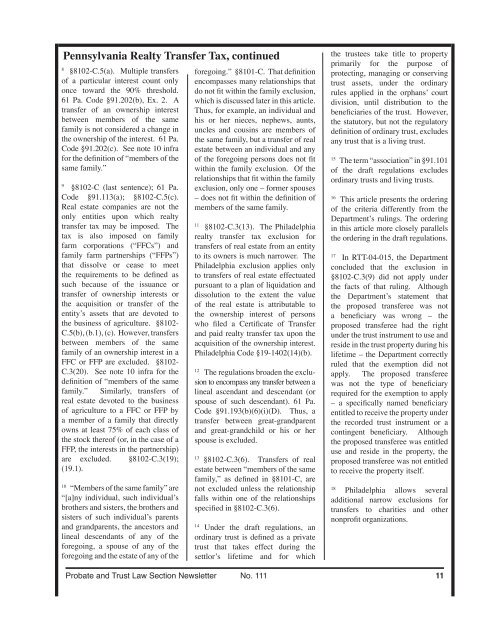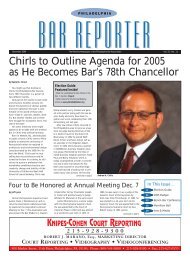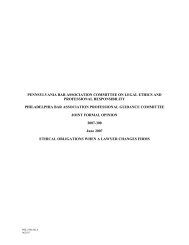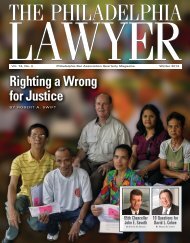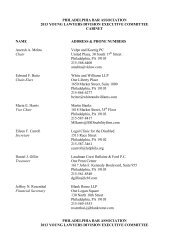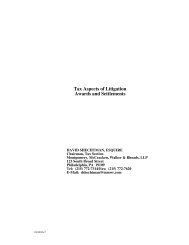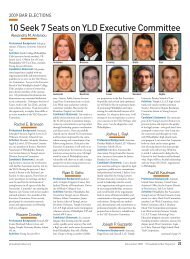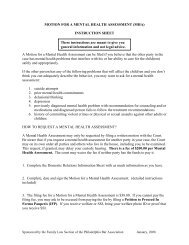Probate & Trust Newsletter: April 2005 - Philadelphia Bar Association
Probate & Trust Newsletter: April 2005 - Philadelphia Bar Association
Probate & Trust Newsletter: April 2005 - Philadelphia Bar Association
You also want an ePaper? Increase the reach of your titles
YUMPU automatically turns print PDFs into web optimized ePapers that Google loves.
Pennsylvania Realty Transfer Tax, continued<br />
8<br />
§8102-C.5(a). Multiple transfers<br />
of a particular interest count only<br />
once toward the 90% threshold.<br />
61 Pa. Code §91.202(b), Ex. 2. A<br />
transfer of an ownership interest<br />
between members of the same<br />
family is not considered a change in<br />
the ownership of the interest. 61 Pa.<br />
Code §91.202(c). See note 10 infra<br />
for the definition of “members of the<br />
same family.”<br />
9<br />
§8102-C (last sentence); 61 Pa.<br />
Code §91.113(a); §8102-C.5(c).<br />
Real estate companies are not the<br />
only entities upon which realty<br />
transfer tax may be imposed. The<br />
tax is also imposed on family<br />
farm corporations (“FFCs”) and<br />
family farm partnerships (“FFPs”)<br />
that dissolve or cease to meet<br />
the requirements to be defined as<br />
such because of the issuance or<br />
transfer of ownership interests or<br />
the acquisition or transfer of the<br />
entityʼs assets that are devoted to<br />
the business of agriculture. §8102-<br />
C.5(b), (b.1), (c). However, transfers<br />
between members of the same<br />
family of an ownership interest in a<br />
FFC or FFP are excluded. §8102-<br />
C.3(20). See note 10 infra for the<br />
definition of “members of the same<br />
family.” Similarly, transfers of<br />
real estate devoted to the business<br />
of agriculture to a FFC or FFP by<br />
a member of a family that directly<br />
owns at least 75% of each class of<br />
the stock thereof (or, in the case of a<br />
FFP, the interests in the partnership)<br />
are excluded. §8102-C.3(19);<br />
(19.1).<br />
10<br />
“Members of the same family” are<br />
“[a]ny individual, such individualʼs<br />
brothers and sisters, the brothers and<br />
sisters of such individualʼs parents<br />
and grandparents, the ancestors and<br />
lineal descendants of any of the<br />
foregoing, a spouse of any of the<br />
foregoing and the estate of any of the<br />
foregoing.” §8101-C. That definition<br />
encompasses many relationships that<br />
do not fit within the family exclusion,<br />
which is discussed later in this article.<br />
Thus, for example, an individual and<br />
his or her nieces, nephews, aunts,<br />
uncles and cousins are members of<br />
the same family, but a transfer of real<br />
estate between an individual and any<br />
of the foregoing persons does not fit<br />
within the family exclusion. Of the<br />
relationships that fit within the family<br />
exclusion, only one – former spouses<br />
– does not fit within the definition of<br />
members of the same family.<br />
11<br />
§8102-C.3(13). The <strong>Philadelphia</strong><br />
realty transfer tax exclusion for<br />
transfers of real estate from an entity<br />
to its owners is much narrower. The<br />
<strong>Philadelphia</strong> exclusion applies only<br />
to transfers of real estate effectuated<br />
pursuant to a plan of liquidation and<br />
dissolution to the extent the value<br />
of the real estate is attributable to<br />
the ownership interest of persons<br />
who filed a Certificate of Transfer<br />
and paid realty transfer tax upon the<br />
acquisition of the ownership interest.<br />
<strong>Philadelphia</strong> Code §19-1402(14)(b).<br />
12<br />
The regulations broaden the exclusion<br />
to encompass any transfer between a<br />
lineal ascendant and descendant (or<br />
spouse of such descendant). 61 Pa.<br />
Code §91.193(b)(6)(i)(D). Thus, a<br />
transfer between great-grandparent<br />
and great-grandchild or his or her<br />
spouse is excluded.<br />
13<br />
§8102-C.3(6). Transfers of real<br />
estate between “members of the same<br />
family,” as defined in §8101-C, are<br />
not excluded unless the relationship<br />
falls within one of the relationships<br />
specified in §8102-C.3(6).<br />
14<br />
Under the draft regulations, an<br />
ordinary trust is defined as a private<br />
trust that takes effect during the<br />
settlorʼs lifetime and for which<br />
the trustees take title to property<br />
primarily for the purpose of<br />
protecting, managing or conserving<br />
trust assets, under the ordinary<br />
rules applied in the orphansʼ court<br />
division, until distribution to the<br />
beneficiaries of the trust. However,<br />
the statutory, but not the regulatory<br />
definition of ordinary trust, excludes<br />
any trust that is a living trust.<br />
15<br />
The term “association” in §91.101<br />
of the draft regulations excludes<br />
ordinary trusts and living trusts.<br />
16<br />
This article presents the ordering<br />
of the criteria differently from the<br />
Departmentʼs rulings. The ordering<br />
in this article more closely parallels<br />
the ordering in the draft regulations.<br />
17<br />
In RTT-04-015, the Department<br />
concluded that the exclusion in<br />
§8102-C.3(9) did not apply under<br />
the facts of that ruling. Although<br />
the Departmentʼs statement that<br />
the proposed transferee was not<br />
a beneficiary was wrong – the<br />
proposed transferee had the right<br />
under the trust instrument to use and<br />
reside in the trust property during his<br />
lifetime – the Department correctly<br />
ruled that the exemption did not<br />
apply. The proposed transferee<br />
was not the type of beneficiary<br />
required for the exemption to apply<br />
– a specifically named beneficiary<br />
entitled to receive the property under<br />
the recorded trust instrument or a<br />
contingent beneficiary. Although<br />
the proposed transferee was entitled<br />
use and reside in the property, the<br />
proposed transferee was not entitled<br />
to receive the property itself.<br />
18<br />
<strong>Philadelphia</strong> allows several<br />
additional narrow exclusions for<br />
transfers to charities and other<br />
nonprofit organizations.<br />
<strong>Probate</strong> and <strong>Trust</strong> Law Section <strong>Newsletter</strong> No. 111 11


